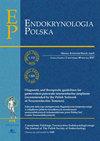A comparison of the 2 thermal ablation procedures for the management of benign thyroid nodules.
IF 2
4区 医学
Q3 ENDOCRINOLOGY & METABOLISM
引用次数: 0
Abstract
INTRODUCTION In recent years, ultrasound (US)-guided thermal ablation techniques have come to the fore as minimally invasive alternatives to surgery. The purpose of this study was to assess the effectiveness and safety of radiofrequency ablation or microwave ablation procedures in patients with benign thyroid nodules. MATERIAL AND METHODS This retrospective and single-centre study consisted of 55 patients and 62 benign thyroid nodules that were treated either with radiofrequency ablation (RFA) or microwave ablation (MWA) in our hospital between January 2020 and March 2022. All the patients were at high risk for surgery or with symptomatic TNs and who refused surgery. The TNs diagnosed as benign from the fine-needle aspiration biopsy were evaluated in terms of volume reduction, symptom, and cosmetic scores. In addition, these 2 treatment modalities were compared to each other. RESULTS Out of 55 patients, 44 (80%) were female and were aged between 24 and 97 years with a median age of 50 years. RFA was applied to 54.5% (n = 30) of the participants, and MWA was applied to 46.5% (n = 25). The volume reduction rate (VRR) after RFA and MWA at the first month was 63.4 ± 14.2 and 65.7 ± 13, respectively. No significant difference was detected between the 2 groups in terms of VRR (p = 0.51). In addition, the mean symptom and cosmetic scores decreased significantly in both procedures, and there was a significant difference due to the symptom score change in the RFA group compared to the MWA group. Of all the patients, one patient experienced haematoma in the RFA, and one patient had transient voice change in the MWA group. No life-threatening complications were noted. CONCLUSION In the treatment of benign symptomatic thyroid nodules, both RFA and MWA are options worthy of consideration in terms of efficacy and safety.两种热消融治疗良性甲状腺结节的比较。
近年来,超声(US)引导的热消融技术已经成为外科手术的微创替代方案。本研究的目的是评估射频消融或微波消融治疗良性甲状腺结节的有效性和安全性。材料和方法:本回顾性单中心研究包括55例患者和62例良性甲状腺结节,于2020年1月至2022年3月在我院接受射频消融(RFA)或微波消融(MWA)治疗。所有患者均为手术风险高或有症状性TNs且拒绝手术的患者。通过细针穿刺活检诊断为良性的TNs,根据体积缩小、症状和外观评分进行评估。并对两种治疗方式进行了比较。结果:55例患者中,44例(80%)为女性,年龄在24 ~ 97岁之间,中位年龄50岁。RFA应用于54.5% (n = 30)的参与者,MWA应用于46.5% (n = 25)。RFA和MWA术后第一个月的体积缩小率(VRR)分别为63.4±14.2和65.7±13。两组间VRR差异无统计学意义(p = 0.51)。此外,两种手术的平均症状和美容评分均显著下降,RFA组与MWA组相比,由于症状评分的变化而存在显著差异。在所有患者中,一名患者在RFA出现血肿,一名患者在MWA组出现短暂的声音改变。没有发现危及生命的并发症。结论:在良性症状性甲状腺结节的治疗中,RFA和MWA在疗效和安全性方面都是值得考虑的选择。
本文章由计算机程序翻译,如有差异,请以英文原文为准。
求助全文
约1分钟内获得全文
求助全文
来源期刊

Endokrynologia Polska
ENDOCRINOLOGY & METABOLISM-
CiteScore
2.60
自引率
9.50%
发文量
129
审稿时长
6-12 weeks
期刊介绍:
"Endokrynologia Polska" publishes papers in English on all aspects of clinical and experimental endocrinology. The following types of papers may be submitted for publication: original articles, reviews, case reports, postgraduate education, letters to the Editor (Readers’ Forum) and announcements of scientific meetings, conferences and congresses.
 求助内容:
求助内容: 应助结果提醒方式:
应助结果提醒方式:


